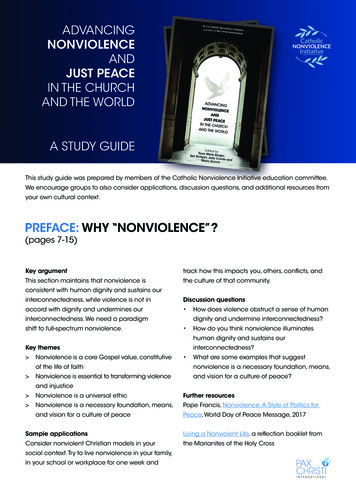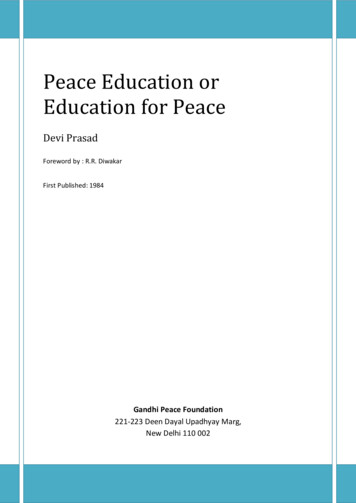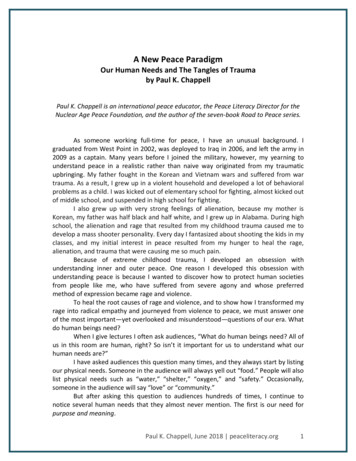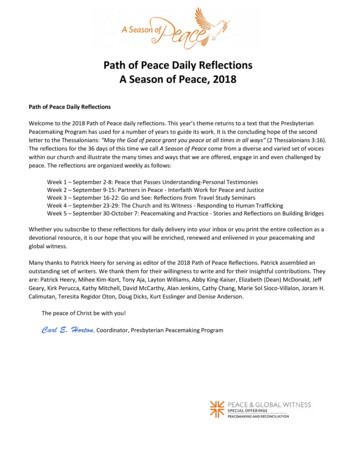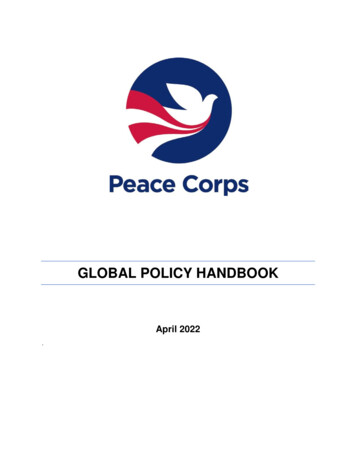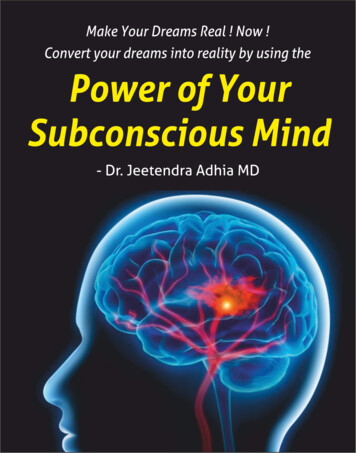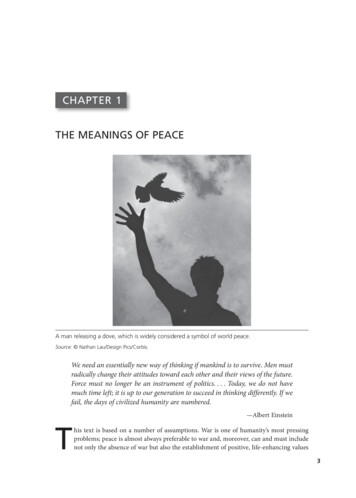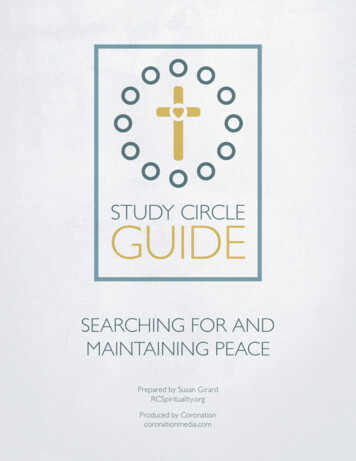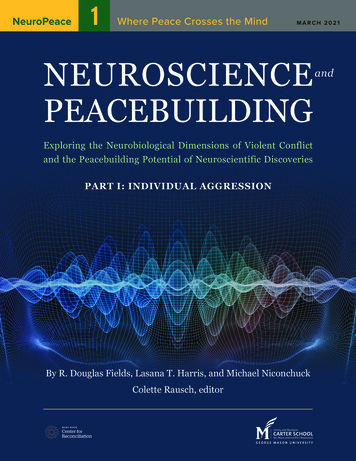
Transcription
Where Peace Crosses the MindMARCH 2021NEUROSCIENCEPEACEBUILDINGExploring the Neurobiological Dimensions of Violent Conflictand the Peacebuilding Potential of Neuroscientific DiscoveriesPART I: INDIVIDUAL AGGRESSIONBy R. Douglas Fields, Lasana T. Harris, and Michael NiconchuckColette Rausch, editorand
About NeuroPeaceNeuroPeace is an online, open source series focusing on research and practice atthe nexus of peacebuilding and neuroscience. NeuroPeace includes articles andessays by scholars and practitioners exploring how neuroscientific insights caninform peacebuilding processes, including supporting dialogue, fostering reconciliation, and preventing violence, as well as addressing the fundamental causes ofdestructive conflict, injustice, and societal divisions.This, the inaugural edition of NeuroPeace, is the first of three parts of an editedvolume that brings together a group of eminent researchers on the frontlines ofneuroscience to share—in a way that is accessible and engaging to nonscientists—their work and to spotlight how it might be relevant and useful to those whowork to prevent wars, terrorism, and other forms of violent conflict and to help societies and individuals to heal in the aftermath of violence. The researchers covera wide range of cutting-edge topics that are grouped under three broad headingsand published in three separate editions: Individual Aggression (NeuroPeace no.1), Group Dynamics (NeuroPeace no. 2), and Trauma (NeuroPeace no. 3).NeuroPeace is sponsored by the Mary Hoch Center for Reconciliation, a centerwithin the Jimmy and Rosalynn Carter School for Peace and Conflict Resolution atGeorge Mason University.For more details about NeuroPeace, email NeuroPeace editor ColetteRausch at crausch@gmu.edu.Mary Hoch Center for Reconciliation3434 N. Washington Blvd.Vernon Smith Hall, 5th FloorArlington, VA 22201The views expressed in this publication are those of the authors. They do notnecessarily reflect views of the Mary Hoch Center for Reconciliation, the Jimmyand Rosalynn Carter School for Peace and Conflict Resolution, George MasonUniversity, and the authors’ own institutional affiliations. Unless otherwise noted,all authors are writing in their personal capacities.The NeuroPeace Editorial TeamColette Rausch, JD, Research Professor, Mary Hoch Center for ReconciliationAntti Pentikainen, Founding Director, Mary Hoch Center for ReconciliationDr. Charles Hauss, Senior Fellow for Innovation, Alliance for PeacebuildingAnnalisa Jackson, Associate Director, Mary Hoch Center for ReconciliationDr. Nigel Quinney, President, The Editorial GroupAngelina Mendes, Research Fellow, Mary Hoch Center for ReconciliationNeuroPeace No. 1. Published March 15, 2021. 2021 by Colette Rausch.
CONTENTSIntroduction, by Colette Rausch51.The Neural Circuitry of Aggression and Practical Applicationsto Peacebuilding, by R. Douglas Fields152.The Impact of Dehumanization on Decision-Making Processesand Violence, by Lasana T. Harris373.Terrorist Cells: Neurobiology and Violent Extremism,by Michael Niconchuk 57Suggestions for Further Reading and Resources87About the Authors 91Acknowledgments 95
IntroductionColette RauschAppropriately enough for a series with the name NeuroPeace, this inaugural issue presents a collection of articles entitled, no less aptly “”Neuroscience and Peacebuilding.”This collection is divided thematically into three parts, and each part will form one of thefirst three issues of the new series, with NeuroPeace no. 1 focusing on the neurologicalroots of individual aggression, NeuroPeace no. 2 on group dynamics, and NeuroPeaceno. 3 on trauma.Collectively, the articles ask—and begin to answer—a deceptively simple question: What can neuroscience contribute to peacebuilding? To date, that contribution hasbeen modest, but the potential is huge. Neuroscientists are making rapid and significant strides in understanding the structure of the nervous system and the brain, and thefield of neuroscience is deservedly attracting increasing attention from researchers andpractitioners—as well as the media and the public at large—eager to see if those discoveries might illuminate problems and solutions in a wide variety of other fields. For peacebuilders, who are increasingly conscious of the shortcomings of technical solutions toconflicts rooted in human perceptions and patterns of thought and behavior, neuroscience may offer insights and knowledge of incomparable value.Neuroscience is not really one field, but many. Historically, neuroscience was narrowly viewed as a subdivision of biology (and it is sometimes still called “neurobiology”).1Today, however, neuroscience is seen as a collaborative and interdisciplinary field thatintegrates several disciplines, including not only biology but also linguistics, psychology,computer science, mathematics, engineering, linguistics, philosophy, chemistry, physics,and medicine.2 Neuroscience has many branches. Some of those cluster around biology,such as neurophysiology, which studies the nervous system and its functions, and molecular and cellular neuroscience, which explores genes and other molecules that guidehow neurons function. Other branches focus on thought and feelings, including affectiveNeuroPeace no. 15
neuroscience, which looks at the role of emotions, and behavioral neuroscience, whichinvestigates how the brain affects the behavior of humans. Yet other branches combinedisciplines in specific applications. One example is neuroengineering, which emphasizesan engineering and quantitative approach to research areas at the molecular, cellular, andsystems levels to address neurological problem such as epilepsy or strokes.Peacebuilding, too, is a broad umbrella under which experts and practitionersgather from diverse fields, including economics, security studies, law, human rights,humanitarian relief, and governance. Broadly speaking, the goal of this disparate castis to help bring about—in societies that are threatened by, in the midst of, and trying torecover from violent conflict—“a transformation toward more manageable, peaceful relationships and governance structures—the long-term process of addressing root causesand effects, reconciling differences, normalizing relations, and building institutions thatcan manage conflict without resorting to violence.”3In pursuit of that goal, peacebuilders could benefit considerably from neuroscience’s insights into subjects such as what drives violent behavior and how to address theroots of violence at both individual and societal levels. Policymakers and practitioners ofpeacebuilding develop “interventions” (a term of art for peacebuilding projects) based inpart on their assessment of a conflict’s root causes. They talk about the “roots” and “drivers” of conflict being such things as lack of inclusion, marginalization, corruption, andweak rule of law. But what if they were also to go even deeper, down into the wiring of thehuman mind?Scientists are making notable advances in understanding how that wiring affectsthe outlooks, predispositions, and decision-making processes of individuals and societies. Neurobiologists and neuroscientists are discovering how the anatomy and physiologyof the brain and nervous system influence how our brains work, while scientists in thefield of neuroepigenetics are exploring how our life experiences can lead to changes in thebrain and how those changes can in turn affect our thinking and behavior.This expanding awareness could be invaluable in understanding not only whatdrives individuals and societies to use violence to resolve their disputes but also whatencourages people to turn from war making to peacemaking—what leads them to embracenegotiation, mediation, reconciliation, and the other components of peace processes.Why and how are prejudice, hate, and fear superseded by or transformed into a consciouschoice for peace? Peacebuilding strategies could be informed by a better understandingof how the neural structure varies across populations; by knowledge of the genetic varia6NeuroPeace no. 1
tions in brain structures and how environmental and cultural conditions influence beliefsand disposition;4 and by research findings about the sources of decision-making and prejudice, and the limits of rationality.5 Neuroscientists are discovering how changes in neurochemistry, neural pathways, and neuro-anatomical transformations in the brain canaffect human emotionality, morality, trauma, and the drive for political power.6 Neuroscience is educating us on the role of empathy in predicting and addressing intergroup violence.7 Recent studies have demonstrated the remarkable plasticity of the human brain,underlining the notion that primordial disposition does not imply predetermination.8The plasticity of the human brain might even hold the promise of sustainable peace byallowing not just for shifts in attitudes but for new neuropathways to be created and newassociations to be formed between, on the one hand, internal states and, on the other,actions and changes in the environment.Such knowledge could help peacebuilders not only understand human societiesbetter but also tackle specific challenges. For instance, neuroscientific research could helpin uncovering the processes and pathways that drive radicalization and make some individuals vulnerable to recruitment by terrorist groups.9 It could also enhance understanding of the impact of trauma on youth in conflict-affected societies and on the prospects forturning those societies into stable and inclusive democracies.Goals, Audience, and Authors“Neuroscience and Peacebuilding” is designed to stimulate interest in such applicationsof neuroscientific knowledge in the cause of building peace in our conflict-plagued world.We do not claim that neuroscience is a peacebuilding panacea; it must be combined withother peacebuilding tools and approaches. Nor do we dismiss it was a fashionable irrelevance; the current tide of media interest in neuroscience’s discoveries may soon subside,but the value of those discoveries will undoubtedly endure.Taking what we trust is a balanced view, this collection seeks to stimulate awareness of the role that neuroscience can plausibly play in peacebuilding. It describes thework being done in a wide variety of areas of the neuroscience field. It assesses the extentto which neuroscience-based insights and techniques have already been used in peacebuilding and with what results. It explores how, when, and where they might be appliedin the future and used in practice.NeuroPeace no. 17
In addition to reaching out to peacebuilders of all stripes, “Neuroscience andPeacebuilding” aspires to help scientists understand how their work might be used inpeacemaking and peacebuilding and to stimulate further research on the nexus of peacebuilding and neuroscience. Researchers, scientists, and scholars and their students fromthe multiple disciplines brought together in this collection will, we trust, find much tospark their interest in the work being done in fields other than their own.All but one of these articles are written by neuroscience researchers. The “neuroscience” label may be misleading, however, insofar as they come from a wide array ofbranches of this broad field, from neurobiology to social psychology to clinical psychologyto neuroepigenetics. The contributors have been selected not only because they are recognized experts and innovators in their fields but also because they have a gift for conveyingcomplex information in an accessible way.This is, we believe, one of the first publications that builds bridges betweenpeacebuilding and neuroscience. There are more than a few volumes that offer generalreaders an introduction either to neuroscience as a whole or to specific aspects or avenues of research within the broad neuroscientific discipline. (The “Further Reading andResources” sections at the end of each part of “Neuroscience and Peacebuilding” spotlighta number of publications and online resources that interested readers can explore.) Andas one would expect in so dynamic an area, books and especially articles aimed at fellowneuroscientists are legion. Although some existing publications have explored the intersection of neuroscience and peacebuilding, none have covered it from as many variantangles as this collection does.“Neuroscience and Peacebuilding” was birthed as part of a wider project housedat the United States Institute of Peace (USIP), a nonpartisan institution funded by theUS Congress and dedicated to preventing, mitigating, and resolving violent conflictsabroad. That project, initiated by Colette Rausch, NeuroPeace’s editor, subsequentlyfound a new home at the Mary Hoch Center for Reconciliation (MHCR) which is partof George Mason University’s Carter School for Peace and Conflict Resolution. In tunewith MHCR’s vision and mission, “Neuroscience and Peacebuilding” (like the NeuroPeace series as a whole) seeks to raise awareness, educate, and spark innovative thought,research, and action. A variety of other initiatives at MCHR—such as the Think PeacePodcast, which debuted in early 2021, as well as webinars, videos, articles, and events—are designed to help peacebuilders become more familiar with and make use of theinsights presented in the following articles.8NeuroPeace no. 1
How “Neuroscience and Peacebuilding” Is OrganizedAs noted above, “Neuroscience and Peacebuilding” is being published in three parts, eachfocused on a broad unifying theme and each part a separate issue of NeuroPeace. Part Iis focused on sources of aggression in individuals and what can cause individuals to reactwith aggression, engage in dehumanizing behavior toward others that can lead to violence, and join violent extremist groups. Moving from the individual to the group, part IIexplores two aspects of the neuroscience of group dynamics, which often have a profoundimpact on violent conflict. Part III focuses on understanding the role of trauma and itsimpact on the individual and group dynamics that affect peacebuilding processes.Part I: Individual AggressionPart I consists of this introduction and three articles. The first of the trio is by R. DouglasFields, an international authority on nervous system development and plasticity and theauthor of Why We Snap: Understanding the Rage Circuit in Your Brain. As the article’stitle—“The Neural Circuitry of Aggression and Practical Applications to Peacebuilding”—makes clear, Fields delves into the architecture of the brain and examines the triggers thatcause individuals to react with aggression. This article begins by highlighting well-knownbut outdated or misleading notions of the neuroscience of aggression—such as the concept of a “lizard brain” controlling the fight-or-flight response. Fields’ bases his argumenton recent experimental research that has enabled neuroscientists to map specific neuralcircuits that relate to aggression. He identifies nine biological triggers of aggression, eachof which can be activated by a certain kind of environmental experience that affects neural pathways associated with aggression. Different types of aggression, the article shows,are mediated by distinct neural circuits.In “The Impact of Dehumanization on Decision-Making Processes and Violence,”Lasana T. Harris, an assoicate professor at University College London, applies a flexiblesocial cognition theory—an understanding of what happens between a network of brainregions that engage and make judgments when encountering or thinking about others—tounpack the process of dehumanization, which he describes as “people having the capacity to treat other people as if they were not in fact people, suspending moral rules andsocial norms that prohibit such violent behavior.” By looking at how underlying brainmechanisms and psychological processes influence moral decision-making (i.e., decisions and beliefs regarding another’s character or personhood), he explains how suchNeuroPeace no. 19
decision-making can facilitate violent conflict and outlines the implications for conflictresolution efforts.In the third and final article in part I, “Terrorist Cells: Neurobiology and ViolentExtremism,” Michael Niconchuk, Program Director for Trauma & Violent Conflict atBeyond Conflict, draws from concepts in psychology and neurobiology to examine keyprocesses that are important factors in typologies of violent behavior. He explores violent extremism as a byproduct of “normal” brains and bodies, based on the evidence thatmost terrorists are normal, without clear psychopathology. Niconchuk argues for a shiftaway from violence prevention strategies that use psychology and neuroscience to predictviolent tendencies and toward a focus on neuroscientific tools that illuminate the brain’sability to adapt and change. This reorientation, he contends, can help dispel commonmyths about terrorism and lead to more effective strategies to address and respond toviolent extremism.Part II: Group DynamicsPart II investigates two aspects of the neuroscience of group dynamics, which can frequently fuel violent conflict, but which, as these two articles explain, can be managed tosupport peacebuilding.In their article “From Conflict to Reconciliation: Bridging Groups by PromotingCommonality,” Aharon Levy from Columbia University, Professor John Dovidio fromYale University, and Professor Tamar Saguy from the Interdisciplinary Center in Herzliya,Israel, explore the foundations of intergroup conflict, social cognition, and the social andfunctional relations between groups. The authors note that psychological and neuroscience perspectives converge to illuminate the processes—social categorization, social identity, and functional interdependence—that underlie and shape relations between groups.When left unmanaged, these processes tend to create and sustain intergroup bias andsocial conflict in ways that represent major barriers to peacebuilding efforts. In addressing these issues, the authors consider common obstacles and potential unintended consequences to category-based social interventions for peacebuilding and suggest practical ways to overcome the barriers to effective peacebuilding. These interventions includecreating opportunities for positive interactions between members of groups in conflict,indirect forms of contact, observing positive cross-group interactions, mentally simulating positive contact experiences, and computer-mediated interactions, all of which canreduce intergroup bias and conflict.10NeuroPeace no. 1
The second article in part II is “A Neurobiological Understanding of How RitualsCan Support Peacebuilding Processes.” The authors—peacebuilding practitioner BeatricePouligny, Professor Dara Ghahremani from UCLA, and Professor Matt Rossano fromSoutheastern University Louisiana—explore how rituals engage individuals and communities with nuanced, diverse, and culturally embedded practices, which both transcendand complement standardized approaches to peacebuilding. The authors review existingneuroscience research that reveals the ability of rituals to support the regulation of emotions, sculpt cognitive control, and refine explicit attentional and memory processes—allfunctions that facilitate positive interactions among individuals. Pouligny, Ghahremani,and Rossano highlight the paradoxical role that spiritual and ritualistic practices can playin either alleviating or exacerbating intergroup bias and us-vs.-them thinking, and theysuggest ways to bypass these difficulties by analyzing the research on the role of ritual inpromoting trust building, interconnectedness, and social bondingPart III: TraumaPart III consists of two articles on different aspects of trauma, plus an article that, whileit touches on trauma, offers a wide-ranging and forward-looking assessment of how andwhy peacebuilders can make use of the knowledge and insights that neuroscientists arecreating.The first article is “Epigenetic Transmission of the Effects of Trauma across Generations: Implications for Individuals and Society” by Dr. Ali Jawaid, Senior Group Leaderat the Center for Neural Plasticity and Brain Disorders BRAINCITY of the Nencki Institute in Warsaw, Poland, and Professor Isabelle Mansuy from the University of Zürichand the Swiss Federal Institute of Technology. The authors explain that epigeneticinheritance does not depend on changes in the DNA sequence. Traumatic experiencescan set in motion molecular mechanisms that alter the activity of the genetic code without changing its sequence. Their analysis reviews studies in animals and humans on theintergenerational and transgenerational transmission of the effects of traumatic stress byaddressing the questions of how trauma exposure and associated emotional and cognitiveperturbations can leave traces in the germline. The authors also discuss the question of“windows of opportunity” at different stages of life, from pre-conception to embryonicdevelopment, postnatal life and adulthood, during which the inheritance of the effects oftrauma may be prevented.NeuroPeace no. 111
The second article, “The Restoration of Resilience: A Neurophysiological Approachto Healing Individual and Collective Trauma,” is by Abi Blakeslee and Glyndie Nickerson,two psychologists and leading practitioners of a trauma resolution approach known asSomatic Experiencing. The authors examine how interoception—the awareness of one’sown bodily sensations—can give individuals access to their nonconscious memory andto signals between their brains and bodies that register whether they are in safety or indanger. They examine how, when, and where individuals may be susceptible to trauma,shifting the discussion on trauma from a traditional emotional and behavioral model ofmental health to a psychobiological perspective. Their approach draws on the fields ofethology (wild animal behavior), interpersonal neurobiology, and psychology. Trauma,argue the authors, lies not in the trauma-inducing event itself, but is held in ongoing signals in the autonomic nervous system that is deeply rooted in our biological imperativefor survival. This article also provides peacebuilders practical exercises to help individuals and communities regulate stress and restore resilience by building on group processesand existing cultural resources.The final article, by Colette Rausch, brings the “Neuroscience and Peacebuilding” collection full circle by making the case for integrating neuroscientific discoveries inpeacebuilding practices by explaining what peacebuilding is and why peacebuilders needthe help of neuroscientists. The article begins by discussing how the term “peacebuilding” has evolved, describes the range of actors that conduct peacebuilding, and spotlightssome of the major challenges facing peacebuilders in the twenty-first century. Rauschunderscores the failures of peacebuilding interventions, citing the limitations of technocratic emphases and donor expectations, which hinder attempts to fully understand howand why people behave as they do during and in the aftermath of violent conflict. Drawing from her own and her colleagues’ experiences working as peacebuilders in war zonesacross the globe, Rausch illustrates the kinds of neuroscientific knowledge and insightspeacebuilders can learn from and use to sharpen their current tools and to develop newapproaches. The article concludes by highlighting several examples of potential practical applications of neuroscientific research, such as helping facilitators manage dialoguebetween angry and antagonistic individuals and groups, turning traumatic experiencesinto a catalyst for personal empowerment and societal resilience, and tackling governancereforms with an awareness of the neural foundations of decision-making processes.*12NeuroPeace no. 1**
Several of the cross-cutting themes that emerge from “Neuroscience and Peacebuilding”underline the scale of the challenges that peacebuilders face and raise some disquietingquestions. For instance, does the discovery that trauma can be passed down from onegeneration to the next mean that the neurological scars of war may never heal? Given thestrength of our instinctive attachment to in-groups and our reflexive responses to outgroups, will humans always be vulnerable to manipulation by fearmongers with politicalambitions and by violent extremists offering both a sense of belonging and an “evil” targeton which violence can be unleashed?But seen from a different angle, such neuroscientific revelations also offer thepromise of more effective peacebuilding. Trauma may sometimes be inherited, but it mayalso be healed—and that inheritance interrupted—by new approaches rooted in a better understanding of how the brain and nervous system process traumatic experiences.Dehumanization—and the genocidal impulses and behaviors it unleashes—may be all tootempting under certain circumstances given how our brains are wired, but perhaps wecan harness our knowledge of moral decision-making to steer individuals and groups tomake more empathetic decisions. Knowledge is power, and self-knowledge—of how andwhy we think, act, react, and interact as we do—gives us the power to alter our behavior.Taken together, the articles in parts I, II, and III make a compelling case for theneed, one, to expand the toolbox which individuals, communities, and institutions canuse to work with our brain and neural connections to help transform societies; and, two,to better understand neuroscience so that we can rewire our brains for peace or at leasthelp short-circuit reactions that lead to violence.Notes1. The terms “neuroscience” and “neurobiology” are sometimes used interchangeably; however, forpurposes of this book, “neurobiology” refers more narrowly to the biology of the nervous system itselfwhereas “neuroscience” refers to anything that has to do with the nervous system.2. This description draws on “Neuroscience,” Nature, accessed November 29, 2018, https://www.nature.com/subjects/neuroscience; and “About Neuroscience,” a page on the website of GeorgetownUniversity’s University Medical Center’s Department of Neuroscience, accessed November 27, ce. See also Christian Nordqvist, “What Is Neuroscience?”Medical News Today, June 26, 2018, hp See also thebox below, “A Short Primer on Neuroscience.”NeuroPeace no. 113
3. Dan Snodderly, ed., Peace Terms: Glossary of Terms for Conflict Management and Peacebuilding(Washington DC: United States Institute of Peace Press, 2018), 67.4. Heejung S. Kim and Joni Y. Sasaki, “Cultural Neuroscience: Biology of the Mind in Cultural Contexts,”Annual Review of Psychology 65, no.1 (2014): 487–514.5. Gayannée Kedia, Lasana Harris, Gert-Jan Lelieveld, and Lotte van Dillen, “From the Brain to the Field:The Applications of Social Neuroscience to Economics, Health and Law,” Brain Sciences 7, no. 94 (July2017): 1–16.6. Nayef Al-Rodhan, “Us versus Them. How Neurophilosophy Explains Our Divided Politics,” OxPol: TheOxford University Politics Blog, October 26, 2016, osophy-explains-divided-politics/.7. E. Bruneau, N. Kteily, and L. Laustsen, L. “The Unique Effects of Blatant Dehumanization on Attitudesand Behavior towards Muslim Refugees during the European ‘Refugee Crisis’ across Four Countries,”European Journal of Social Psychology 48, no. 5 (August 2018): 645–662, jsp.23578. Emile Bruneau. “Understanding the Terrorist Mind,” Cerebrum, November 2016.9. Mike Niconchuk and Kyle Dietrich, “Two Sides of the Same Coin? An Examination of the Cognitiveand Psychosocial Pathways Leading to empowerment and radicalization, and a Model for ReorientingViolent Radicalization,” YouthPower, last modified May 17, 2018, del-reorienting-violent10. 9514NeuroPeace no. 1
1The Neural Circuitry of Aggressionand Practical Applicationsto PeacebuildingR. Douglas Fields*Since war begins in the minds of men, it is in the mindsof men that the defenses of peace must be constructed.—UNESCO ConstitutionTo promote peacebuilding, it is necessary to understand the root causes of aggression andviolence, because the first step in managing anything is understanding. Politics, sociology,and psychology all provide valuable perspectives to understand conflict, but advancesin neuroscience are now producing fresh insight into the biology of aggression. Thesescientific findings can be applied practically in addressing conflicts between individuals,groups, and nations. From the biological perspective, aggression and violence are behaviors, and like all behaviors they are controlled by the brain. New research is identifyingthe neural circuits that control aggression, overturning out dated notions, and contributing an informed approach to help reduce human conflict.It may seem that the origins of human conflict are infinite and bewilderingly complex, but from a biological perspective, this is not true. Only a small number of specificsituations will provoke anger and aggression. The reason for this is that engaging in violence puts an individual’s life and limb at risk. Therefore, aggressive behavior is highlycontrolled at the level of brain biology.Just as eating is life-threatening, and therefore regulated by powerful brain circuitry that has evolved over eons to preserve the species, so too have intricate and powerful* This article is written in the author’s personal capacity.NeuroPeace no. 115
circuits in the brain evolved to initiate and inhibit aggression. It is nearly impossible toeat anything that smells foul. Appetite is ins
branches of this broad field, from neurobiology to social psychology to clinical psychology to neuroepigenetics. The contributors have been selected not only because they are recog - . of George Mason University's Carter School for Peace and Conflict Resolution. In tune with MHCR's vision and mission, "Neuroscience and Peacebuilding" .


